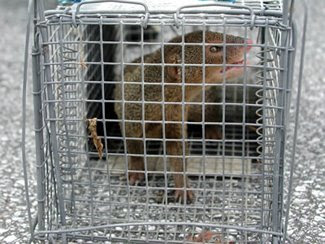
Mongoose
Controlling the mongoose and feral cat population is key to preserving these endangered species. When Joanne & I were hiking up north this past weekend in the Yanbaru forest, we observed many live traps set along the trail as part of an ongoing mongoose & feral cat eradication program. Although we didn't see any captured animals (or Habu), we did see a van along the road with a several men resetting traps. (BTW, I did see my first Pryer's Woodpecker, a bird endemic only to northern Okinawa.)

Mongoose in Trap
And in case you were wondering,Trimeresurus flavoviridis, or the Okinawan Habu, is a true pit viper averaging 4-5 feet in legth. They are not typically aggressive but will bite if provoked. Until recently over 300 people in a year used to be bitten by the snake while working in the field or in one’s garden. The snake often occurs in close proximity to country homes in search of rats and mice and it is not uncommon to encounter one inside houses, barns, etc. Though fatal cases are rare since the intoduction of anti-venom, Habu-biting incidents still number about 100 a year in Okinawa. Its potent venom combined with its nasty temperment is feared and revered in the islanders’ mind.

Habu

1 comment:
It puts me in mind of the "rabbits in Australia" fiasco. I don't mch like the idea of trapping critters, but it appears they are using humane traps, and sometimes it just needs to be done. I am anjoying your posts to this blog tremendously and love getting a feel for your new culture!
Post a Comment